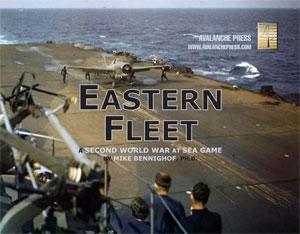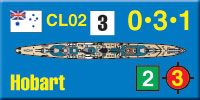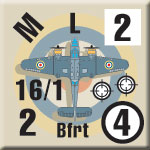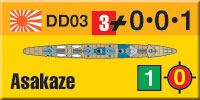| Eastern Fleet:
Designer Preview, Part Two
By Mike Bennighof, Ph.D.
November 2018
 We’ve published Second World War at Sea games since the turn of the century, but only in the last few years have they really taken the story-telling form I always wanted for them. History is a story (it’s right there in the word), and a well-done game should tell the story of whatever it purports to represent. We’ve published Second World War at Sea games since the turn of the century, but only in the last few years have they really taken the story-telling form I always wanted for them. History is a story (it’s right there in the word), and a well-done game should tell the story of whatever it purports to represent.
We’ve taken that approach in a number of expansion books, and in the alternative-history game Tropic of Capricorn. Eastern Fleet Second Edition is the first historical game released under this style, and I’m very happy with the results. It’s a new game, carrying over only one sheet of playing pieces, and I really regret not giving it a new title to match (and almost did so at the very last minute).
In the first part of this preview, I rambled on about the game’s operational scenarios, almost all of which are completely new (a couple cover the same actions as scenarios from the first edition, but they’ve been totally replaced).
 Of the thirty scenarios total, eighteen of them are battle scenarios, which take place only on the Tactical Map. When I designed the first edition of Eastern Fleet I had not yet come to value the battle scenario as a valued means to play the game in itself, much less as a method of telling the game’s story. Nick Rider’s odes to the Battle Scenario prompted me to consider them more seriously, and I realized that they need to play a much greater role in the overall game experience. Of the thirty scenarios total, eighteen of them are battle scenarios, which take place only on the Tactical Map. When I designed the first edition of Eastern Fleet I had not yet come to value the battle scenario as a valued means to play the game in itself, much less as a method of telling the game’s story. Nick Rider’s odes to the Battle Scenario prompted me to consider them more seriously, and I realized that they need to play a much greater role in the overall game experience.
Eastern Fleet’s first edition had just three battle scenarios. One was based on a convoy operation, and drew on incomplete and inaccurate sources to present a battle that not only didn’t happen, but couldn’t have happened within the context of the campaign (some of the ships were far, far away at the time). The other two just drew on pieces to create random battles: one with battleships, one with cruisers. Those were intended to let players try out the tactical systems without marching all the way through an operational scenario, and they were very much an afterthought.
With the second edition, the battle scenarios form an integral part of the game and its historical narrative. I immediately threw away all three of the old ones, and replaced them with 18 completely new battle scenarios.
 The battle scenarios are spread throughout the scenario book, the support the narrative of the operational scenarios. Since the Indian Ocean campaign saw no surface actions of any size of importance, all eighteen are hypothetical. The difference between these and the old “throw a few pieces on the table” style is that each is tied to an operational scenario, and represents a battle likely to arise from that operation. The battle scenarios are spread throughout the scenario book, the support the narrative of the operational scenarios. Since the Indian Ocean campaign saw no surface actions of any size of importance, all eighteen are hypothetical. The difference between these and the old “throw a few pieces on the table” style is that each is tied to an operational scenario, and represents a battle likely to arise from that operation.
That structure helps illustrate the historical narrative, showing rather than telling. During the initial Japanese forays into the Indian Ocean the British did not challenge them, holding back around Ceylon to await reinforcements. There are operational scenarios allowing the British to challenge the Japanese with what forces were available in the Indian Ocean, taking the same aggressive posture as the British, American, Dutch and Australians did during the just-concluded East Indies campaign. It’s the battle scenarios that show, rather than tell, why this would have been a terrible idea – while the British have three battleships, and the Japanese have none, the big Japanese destroyers with their huge torpedo batteries will take target practice on the lumbering R-class dreadnoughts.
The main event, the Japanese First Air Fleet’s foray into the Indian Ocean to attack Ceylon, is covered by three operational scenarios and six battle scenarios. The operational scenarios allow players to pick up the operation at different stages. The battle scenarios look at a couple of vry different aspects of the campaign.
First Air Fleet’s commander, Chuichi Nagumo, had spent his career as a torpedo warfare specialist prior to overseeing Japan’s six fleet carriers. Naturally enough, he saw his supporting fast battleships, cruisers and destroyers as an arm of his striking force, not an adjunct or escort. If the opportunity presented itself, he had no problem unleashing his surface ships against an enemy.
 Vice Admiral Sir James Somerville (promoted to full admiral during the course of the battle) led the Eastern Fleet from the modernized old battleship Warspite, apparently a sentimental choice as she had been his first command. Somerville had participated in the hunt for the German battleship Bismarck and commanded at the Battle of Cape Spartivento, but apparently felt that the Battle of Cape Matapan (where Andrew Cunningham had the command) to be the model for British fleet operations: carrier planes would slow the enemy’s heavy ships, to allow the slower British battleships to catch up and shoot them to pieces. Vice Admiral Sir James Somerville (promoted to full admiral during the course of the battle) led the Eastern Fleet from the modernized old battleship Warspite, apparently a sentimental choice as she had been his first command. Somerville had participated in the hunt for the German battleship Bismarck and commanded at the Battle of Cape Spartivento, but apparently felt that the Battle of Cape Matapan (where Andrew Cunningham had the command) to be the model for British fleet operations: carrier planes would slow the enemy’s heavy ships, to allow the slower British battleships to catch up and shoot them to pieces.
That put the battleships at the center of his thinking, and Somerville made several plans to close with the Japanese as the operation unfolded. Not only did he hope to bring his battleships into action (or at least his one moderately fast ship, Warspite), but he also considered a night-time torpedo attack by his cruisers and destroyers.
Those intentions by the two admirals are the basis for four of the battle scenarios, and they help illustrate what each commander hoped to achieve and how realistic their plans (in Somerville’s case, they bordered on suicidal bravery; in Nagumo’s they were overkill given his air group’s striking power).
 The other two are an experiment: battle scenarios based on air strikes, one featuring each side. The very first Second World War at Sea game included one, as did the first edition of Midway, but we dropped them afterwards as I wasn’t sure this type of scenario provided enough fun. I’m still not sure about that, but they definitely help move the historical narrative forward. The scenarios make clear the massive firepower represented by the Japanese air groups, and the enormous risk Somerville took to challenge them – even if the British roll nothing but 6’s, they can score a strategic victory but they just don’t have the striking power to knock out the Japanese carriers in one attack. The other two are an experiment: battle scenarios based on air strikes, one featuring each side. The very first Second World War at Sea game included one, as did the first edition of Midway, but we dropped them afterwards as I wasn’t sure this type of scenario provided enough fun. I’m still not sure about that, but they definitely help move the historical narrative forward. The scenarios make clear the massive firepower represented by the Japanese air groups, and the enormous risk Somerville took to challenge them – even if the British roll nothing but 6’s, they can score a strategic victory but they just don’t have the striking power to knock out the Japanese carriers in one attack.
In addition to the three operational scenarios based on the Japanese attack on Ceylon, a fourth is based on the Japanese operation Somerville believed to be under way, with only two fleet carriers and a fifth on the raid into the Bay of Bengal by a light carrier and a cruiser squadron that took place at the same time. Each of these has a matching battle scenario, letting us get some of the more unusual ships in the mix some tactical action.
 Another British fear concerned a Japanese fast battleship breaking out into the Indian Ocean similarly to the Bismarck’s sortie; just why the Japanese would obligingly play into British strengths in that manner wasn’t explained (despite the object lesson of Pearl Harbor, the British vastly under-estimated Japanese carrier capabilities during this period). That does let us set up another battleship action, where the British have the edge – the excellent marksmanship of Japanese cruisers and destroyers was more than offset by the poor shooting of their battleship gun crews. Another British fear concerned a Japanese fast battleship breaking out into the Indian Ocean similarly to the Bismarck’s sortie; just why the Japanese would obligingly play into British strengths in that manner wasn’t explained (despite the object lesson of Pearl Harbor, the British vastly under-estimated Japanese carrier capabilities during this period). That does let us set up another battleship action, where the British have the edge – the excellent marksmanship of Japanese cruisers and destroyers was more than offset by the poor shooting of their battleship gun crews.
Two more operational scenarios are based on convoy operations (one British, one Japanese) that actually took place; the attacks on the convoys by surface ships did not happen, but the battle scenarios show how they probably would have played out had contact been made. Two others are drawn from invasion plans, the Japanese invasion of Ceylon and British invasion of the Andaman Islands, with matching battle scenarios.
With Eastern Fleet Second Edition, we finally have what I wanted for Second World War at Sea games: lots of play value in the box and a strong historical narrative. The battle scenarios are the key to both of those. I think you’re going to like this game.
Click here to order Eastern Fleet!
Sign up for our newsletter right here. Your info will never be sold or transferred; we'll just use it to update you on new games and new offers.
Mike Bennighof is president of Avalanche Press and holds a doctorate in history from Emory University. A Fulbright Scholar and award-winning journalist, he has published over 100 books, games and articles on historical subjects.
He lives in Birmingham, Alabama with his wife, three children and his dog, Leopold.
|
